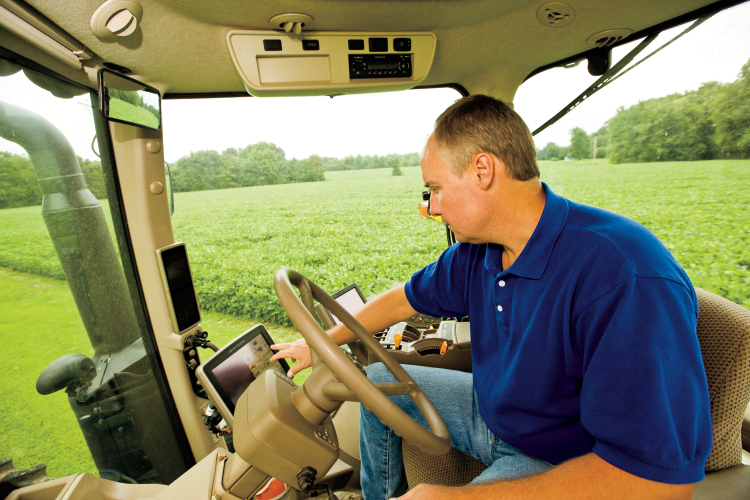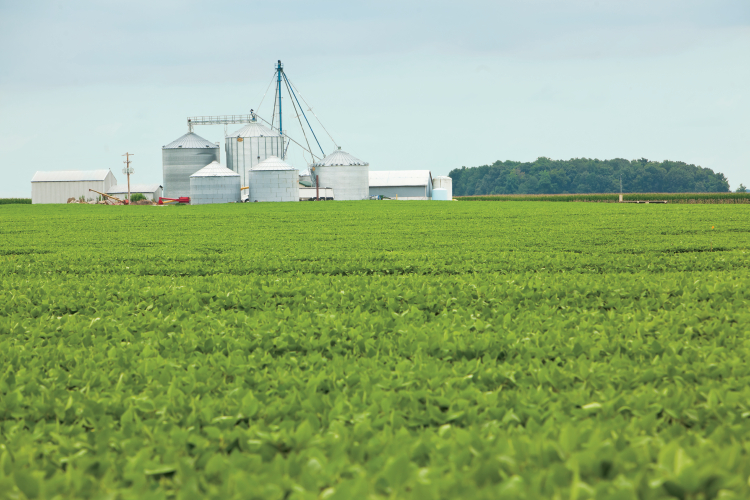Home > Kentucky > Kentucky Technology > Modern Farming in Kentucky
Modern Farming in Kentucky
For Chris Kummer, 2013 has been a good year. The Franklin farmer’s 3,000 acres of cropland have produced one of the best bounties of his career.
“The corn and beans are looking about as good as they ever have since I started farming in 1990,” says Kummer.
The 2013 growing season has been ideal, but Kummer points to another factor, one he can control much more than the weather.
“Technology is really benefiting how much we can produce,” he says.
Kentucky’s corn and soybean harvest is increasing, partially thanks to technology that helps farmers produce more bushels per acre. For example, in the 1970s and 1980s, Kentucky’s best yearly average corn yields were between 100 and 120 bushels per acre. From 2008 to 2012, the five-year average yield was 127 bushels per acre – including a 2012 drought year that saw a 71-bushel statewide average.
Even in that drought year, according to the Kentucky Corn Growers Association, the 2012 crop was valued at more than $749 million, having a total economic impact of $1.27 billion on the state while supporting 27,313 jobs.
“Farmers today are more sophisticated, not only with the technology on their farm but also with their business,” says Dr. Chad Lee, a University of Kentucky Extension agronomist specializing in corn, soybeans and wheat. “Farmers are using better business management systems for things like payroll, staff training and office management. As farms are getting more advanced, that allows them to hire additional employees.”
Some of those jobs could be on the farm, or they may be off the farm, such as at the local company Kummer hires to apply precise amounts of fertilizer on his land using GPS technology.
“We started using variable-rate fertilizer technology almost 15 years ago,” he says.
Soil samples, tied to satellite mapping coordinates, are collected across his fields and analyzed for each quadrant’s nutrient needs. GPS-linked application equipment automatically adjusts the amount of fertilizer applied, putting only the nutrient levels needed on each part of the field.
“Our grain yields increase, and we don’t over-apply fertilizer, and that aids in maintaining good soil and water quality,” Kummer says.
Kummer’s own equipment also uses new technology that helps him avoid planting too much in a field. “We have very few fields that are square, so it can be difficult to get rows planted just right, without any overlapping,” he says (Overlapping plants compete with each other for nutrients, reducing yields). “Our new John Deere planter and tractor have technology that ‘remembers’ where it planted, so that it doesn’t replant the same location.”
That planter also automatically adjusts planting depths using an active down-pressure technology, new on the market in 2013. Kummer has already seen benefits as bottom soil may be fairly moist at planting while higher in the same fields might be drier and harder.
“The planter senses how soft the soil is and automatically adjusts down-pressure on each row unit to keep the seed placed at the right depth,” he says.
Lee explains that such technology has come a long way.
“When these technologies first came out on the market, we thought it would be great if they were accurate within 3 feet,” he says. “Now they are accurate within 1 inch.”
Kentucky soybean farmers will harvest about 1.59 million acres of soybeans, around 70 million bushels, in 2013. The 2012 crop was worth more than $853 million, according to the USDA, with a similar value likely in 2013. As with corn, advancing soybean production technology stimulates economic benefits beyond the farmstead. A company in Elkton manufactures conservation-tillage attachments for planters like Chris Kummer’s John Deere.
Crop spraying technology is also advancing, Kummer says. He explains, “Our sprayers use automatic GPS systems to steer and shut off at the ends of rows so they don’t overspray. Chemicals we use today do not stay in the environment as long as they used to, but the systems guard against any over-application.”
The technology saves farmers money, improves crop yields and makes sense.
“Farmers make their living from healthy soil and water, and that helps us guard the environment,” Kummer says.






